Bulletin – September 2017 Finance Structural Liquidity and Domestic Market Operations
- Download 1.8MB
Abstract
The Reserve Bank is a net supplier of liquidity to the Australian financial system. This reflects demand for the Reserve Bank's liabilities from its customers, as well as the asset allocation decisions of the Reserve Bank. The key drivers of variations in the amount of liquidity supplied by the Reserve Bank have been fluctuations in government deposits and the demand for banknotes. The Reserve Bank meets the demand for liquidity through its domestic market operations.
Introduction
The role of the Reserve Bank's domestic market operations is to manage the availability of liquidity in the financial system. In this context, ‘system liquidity’ refers to the end-of-day balances held by financial institutions in their Exchange Settlement (ES) accounts. System liquidity is managed to ensure that the cash rate trades at the target set by the Reserve Bank Board and to facilitate the settlement of financial institutions' payment obligations.
Every transaction carried out between the Reserve Bank or its clients (mainly the Australian Government and foreign central banks) and the financial system directly affects the size and/or composition of the Reserve Bank's balance sheet, as well as the availability of system liquidity.[1] These transactions can be classified as arising from two sources.
- Exogenous transactions are typically initiated at the request of the Reserve Bank's customers, such as the lodgement of a deposit (by the government at the Reserve Bank) or the issuance of banknotes (by the Reserve Bank to a bank). They may also be initiated by the Reserve Bank for policy purposes related to the management of foreign exchange reserves (see below for further details).
- Domestic market operations refer to those transactions initiated by the Reserve Bank in order to adjust liquidity within the financial system. They are conducted in response to exogenous transactions and realign system liquidity with the demand by financial institutions at the cash rate target. These transactions include repurchase agreements (repos), foreign exchange swaps and/or transactions in outright securities.[2]
At any point in time, the ‘structural liquidity’ position of the financial system vis-à-vis the Reserve Bank is defined as the excess liquidity that would exist in the absence of the Reserve Bank's domestic market operations (for further details on the mechanics see Appendix A).[3] In other words, the structural liquidity position of the system can be identified as the net value of all exogenous transactions. When the net value of those transactions withdraws liquidity from the system, this implies a structural shortage, or deficit, of liquidity. That would require the Reserve Bank to add liquidity using domestic market operations. The opposite would be true when the net value of exogenous transactions adds liquidity into the system.
The Australian financial system has operated with a persistent structural liquidity deficit since 2000, although it has fluctuated within quite a wide range of between $18 billion and $115 billion during this time (Graph 1). Hence, the Reserve Bank has been a net supplier of liquidity through its domestic market operations. Changes in the structural liquidity position over time can be seen to have arisen from four key areas of the balance sheet: banknotes on issue; government deposits; gold and foreign exchange reserves; and the demand for ES balances by financial institutions.
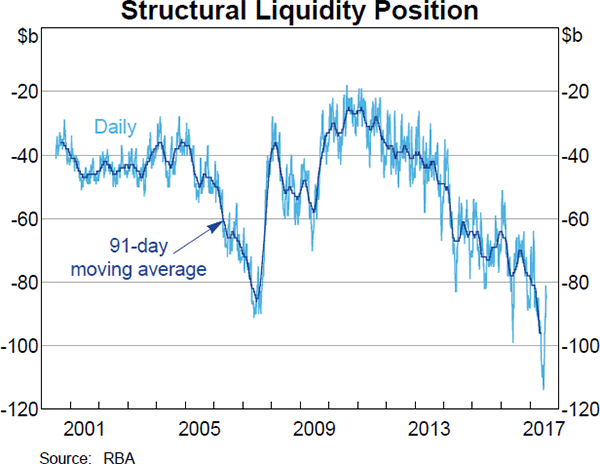
The Exogenous Drivers of the Structural Liquidity Position
Banknotes on issue
The stock of banknotes in circulation is the largest balance sheet item that affects the structural liquidity position of the financial system. A commercial bank may request to purchase banknotes from the Reserve Bank on behalf of the public (its customers). Because the settlement of these purchases occurs in ES balances, liquidity is reduced when the commercial bank's ES account is debited (to pay for the banknotes), and this contributes to a structural liquidity deficit.
As the Reserve Bank supplies banknotes to meet the public demand for cash on a daily basis, seasonal changes in demand can generate considerable short-term variation in the structural liquidity position, such as around Christmas and Easter. On top of this short-term volatility, the long-run growth in the demand for banknotes has acted to increase the structural liquidity deficit over time (Graph 2).[4]
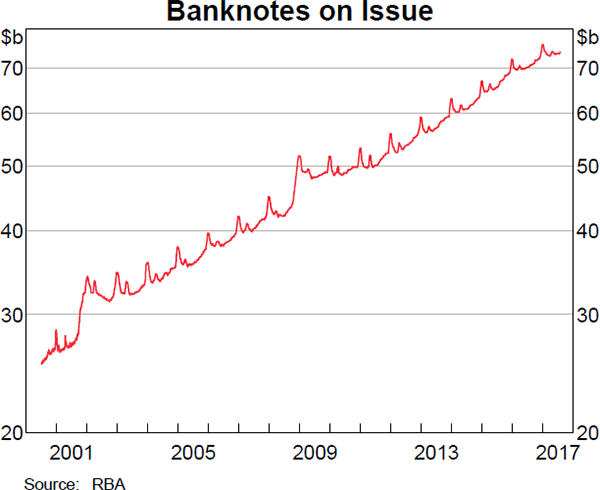
Government deposits
Transactions involving government accounts held at the Reserve Bank and the rest of the economy affect the structural liquidity position of the financial system. For example, when the government receives taxes into its account, liquidity is withdrawn from the system as ES balances of the banks are used to make payments to the government's account at the Reserve Bank. This process increases the structural liquidity deficit of the financial system. Conversely, the government paying out funds, such as when a government bond matures, contributes to a structural liquidity surplus (as government deposits at the Reserve Bank are transferred to ES balances of the banks). Changes in government deposits are responsible for most of the day-to-day variation in the structural liquidity position (Graph 3). These changes occur because of the mismatch in timing between government expenditure and receipts.
The increase in government deposits between 2004 and 2007 drove a significant increase in the structural liquidity deficit. These deposits arose from budget surpluses that were generally held on deposit at the Reserve Bank. The rapid decline in deposits in late 2007 was associated with the creation of the Future Fund and the subsequent withdrawal of these deposits from accounts held at the Reserve Bank. As a result of these withdrawals, there was a commensurate decrease in the structural liquidity deficit. Since 2012, the government has increased the balances it has placed on deposit at the Reserve Bank. Some of the increase in deposits reflects the prefunding of nominal expenditure, which has increased. The build-up and subsequent run-down in the government's account for these purposes has contributed to an increase in both the variability and level of the structural liquidity deficit.
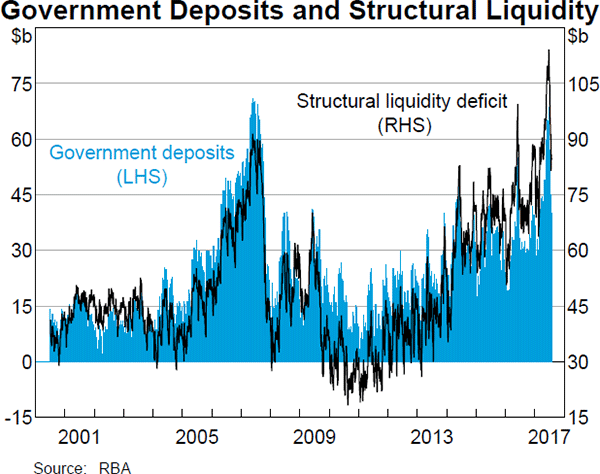
Gold and foreign exchange reserves
Gold and foreign exchange reserves are held by the Reserve Bank for a variety of reasons, including for potential exchange rate intervention and other policy purposes.[5] When the Reserve Bank acquires foreign exchange reserves, it pays for the foreign currency by selling Australian dollars to a bank. As the settlement of the Australian dollars occurs in the bank's ES account, a purchase of foreign currency will lead to an increase in liquidity as its ES account is credited. Although these transactions affect domestic liquidity, they are classified as exogenous transactions as they are typically initiated by the Reserve Bank for policy reasons other than managing domestic liquidity.
The increase in foreign exchange reserves between 2002 and 2006 largely reflected the process of replenishing reserves following the preceding period of intervention ending in 2001 (Graph 4).[6] In more recent years, however, valuation effects have been the main driver of the increase in gold and foreign exchange reserves; these valuation effects only affect structural liquidity if they are realised as part of a transaction with the Reserve Bank.
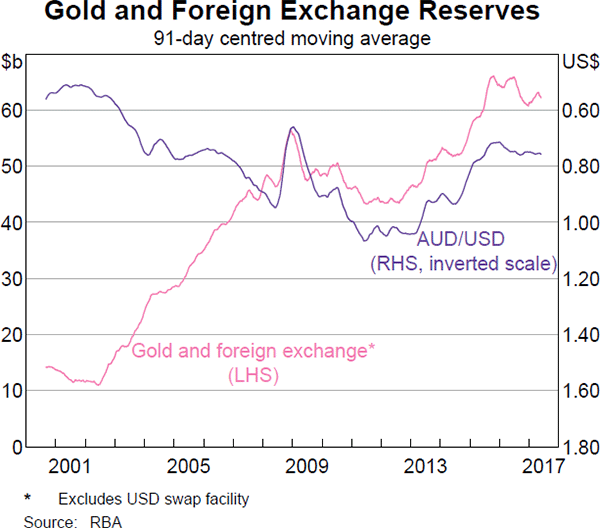
Exogenous changes in the demand for ES balances
Banks and a range of other financial institutions hold ES accounts at the Reserve Bank to facilitate the settlement of payments, both with each other and the Reserve Bank. Through its domestic market operations, the Reserve Bank seeks to ensure that the supply of ES balances is sufficient to meet the prevailing demand by financial institutions and ensure that the cash rate trades at its target.[7]
Prior to the global financial crisis, financial institutions typically sought to maintain their aggregate ES balances at around $750 million (red columns in Graph 5). The onset of the financial crisis, however, led to an increase in banks' demand for ES balances, resulting in a commensurate increase in the structural liquidity deficit in 2007–09. To accommodate this additional demand, the Reserve Bank increased the supply of ES balances though its domestic market operations. As conditions in financial markets normalised, the structural liquidity deficit declined as the precautionary demand for ES balances subsided.
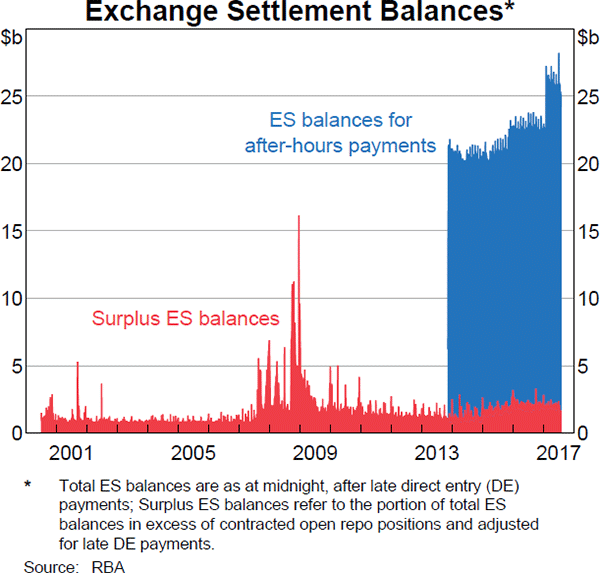
The introduction of the same-day settlement of direct entry (DE) payments in November 2013 saw financial institutions increase their holding of ES balances. This was to ensure that they would have sufficient liquidity buffers to meet their payment obligations outside of normal banking hours. This increase in the structural liquidity deficit could have been accommodated through domestic market operations. However, a new standing facility, known as ‘open repos’, was set up to supply liquidity for after-hours payments purposes independently of domestic liquidity operations.[8] As a result, there was no net change in the structural liquidity position arising from the introduction of the same-day settlement of DE payments.
From January 2015, there has been a slight increase in the size and volatility of demand for ES balances from banks seeking to comply with the Liquidity Coverage Ratio (LCR) by holding additional ES balances.[9] In response to this change in demand, the Reserve Bank regularly adjusts the quantity of ES balances available. Due to the relatively small magnitude of these changes, the impact on the day-to-day structural liquidity position is typically not appreciable.
Long-run Trends in the Structural Liquidity Position
Since 2000, structural liquidity has behaved in somewhat different ways across five different episodes (Graph 6):
- Stability (2000–03) – the structural liquidity position fluctuated in a relatively small range. This reflected increases in the stock of banknotes on issue that were coincidentally offset by other exogenous transactions. In the first half of the period, this was largely due to decreases in government deposits. In the second half, this reflected increases in gold and foreign exchange reserves as a result of reserves replenishment activity.
- Budget surpluses and the Future Fund (2004–07) – the structural liquidity deficit increased largely in response to increases in government deposits, although the ongoing issuance of banknotes also contributed. Partially offsetting this was a further replenishment of foreign exchange reserves. At the end of the period, the withdrawal of deposits by the Future Fund (from the Reserve Bank's accounts) led to a sharp increase in structural liquidity as these balances were transferred to the financial system.
- Global financial crisis (2008–09) – the financial crisis saw an increase in the precautionary demand for banknotes and ES balances, which drove a small increase in the structural liquidity deficit. The increase in gold and foreign exchange reserves during this period predominantly reflected valuation effects that were offset by a commensurate increase in other liabilities on the balance sheet.
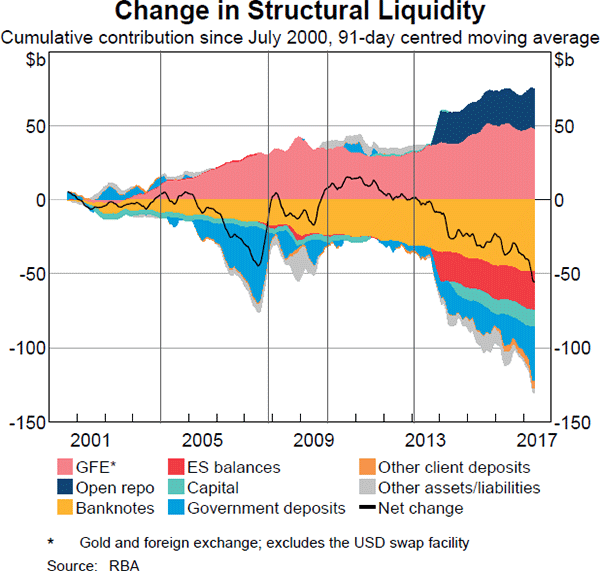
- Stability (2010–12) – the issuance of banknotes was more subdued as the demand for precautionary cash holdings normalised, offsetting some of the trend growth. There was no material change in structural liquidity arising from transactions in gold and foreign exchange reserves, and government deposits were relatively stable throughout this period.
- Government deposits and the issuance of banknotes (2013–17) – the increase in the structural liquidity deficit largely reflected an increase in government deposits. The ongoing issuance of banknotes drove much of the remaining increase in the structural liquidity deficit. The introduction of same-day settlement of DE payments had no net impact on the structural liquidity position as the increase in payments demand for ES balances was offset by the supply of liquidity through open repos.
Sterilising the Structural Liquidity Deficit
The Reserve Bank prepares daily forecasts of changes in structural liquidity in order to assess the appropriate size of its open market operations each morning.[10] Further operations can be conducted later in the day if needed to ensure that the liquidity available at the end of the day meets the system's demand. Due to the persistent structural liquidity deficit, domestic market operations have generally sought to inject liquidity into the system. This has been supplied through a combination of repos, foreign exchange swaps and outright purchases of government securities (Graph 7).[11],[12]
When conducting domestic market operations, the Reserve Bank takes a number of factors into consideration. These include conditions in domestic markets, interactions with market participants, the expected returns on its investments and projections of future changes in the structural liquidity position. Reflecting these factors, the Reserve Bank's use of different types of transactions to manage the structural liquidity position has varied over time:
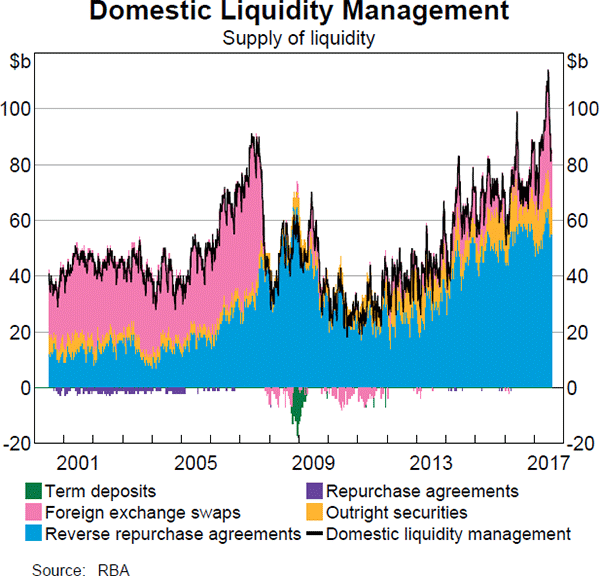
- The early 2000s – domestic market operations were influenced heavily by the increase in the Reserve Bank's balance sheet and the consolidation of the Australian Government Securities (AGS) market. The decline in the amount of AGS on issue limited the availability of collateral to secure lending under repos. At the same time, government budget surpluses resulted in additional funds being placed on deposit, increasing the structural liquidity deficit, which needed to be offset through domestic market operations. If the Reserve Bank had conducted most of its transactions in the repo market, this combination of factors would have led the Reserve Bank to hold an increasingly large proportion of AGS outstanding.[13] Some of these limitations were overcome through the progressive widening of the range of collateral eligible to secure reverse repo transactions. However, the persistent structural liquidity deficit meant that foreign exchange swaps (which do not involve the use of AGS collateral) were an important part of domestic market operations.[14],[15] Repo transactions were also conducted on a small number of days each month to assist in withdrawing liquidity when there was a large increase in structural liquidity.[16]
-
The global financial crisis – in late 2007, following the withdrawal of deposits by the Future Fund, the structural liquidity deficit of the system declined. To offset the corresponding increase in structural liquidity, the Reserve Bank allowed its use of foreign exchange swaps to wind down. At the same time, the onset of the global financial crisis saw the Reserve Bank alter the composition of its assets towards domestic securities markets by supplying additional liquidity through repos (secured by a wider range of eligible domestic collateral) in response to the impact of the crisis.[17]
To facilitate the provision of liquidity to term domestic securities markets, the Reserve Bank regularly offered to transact at longer terms in its repo operations. One implication of this was that the liquidity provided through these operations did not need to be rolled over (or resupplied) as frequently. In order to continue supplying liquidity to these markets without increasing the overall amount of liquidity available in the system, the Reserve Bank offered to withdraw the excess (short-term) liquidity. This was achieved through a combination of foreign exchange swaps and the introduction of a term deposit facility. This process had the effect of ensuring that the net liquidity supplied through domestic market operations was consistent with the system's demand for liquidity.
-
The post-crisis period – since the financial crisis, liquidity has been provided mainly using repos. Growth in the repo book over this period has been supported by an increase in the stock of eligible securities, particularly as the issuance of AGS and semi-government securities has increased. The expansion of collateral eligibility and changes in financial markets makes it difficult to compare market shares over time. Nonetheless, it is clear that the Reserve Bank has become a more important supplier of funds into the repo market over recent years (Graph 8).
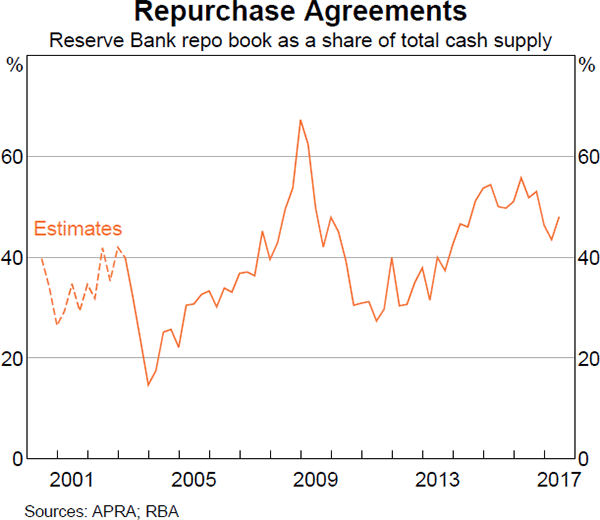
The repo market has only limited ability to absorb rapid changes in the Reserve Bank's positions. The Reserve Bank has therefore increasingly used foreign exchange swaps and outright securities transactions in response to larger fluctuations in the structural liquidity position (Graph 9). Outright securities have been mainly used to manage the liquidity impact of AGS bond maturities, with the associated structural liquidity injections on some days now regularly exceeding $15 billion. Foreign exchange swaps have also been utilised more over recent years to assist in the management of some of the more regular large fluctuations in structural liquidity.
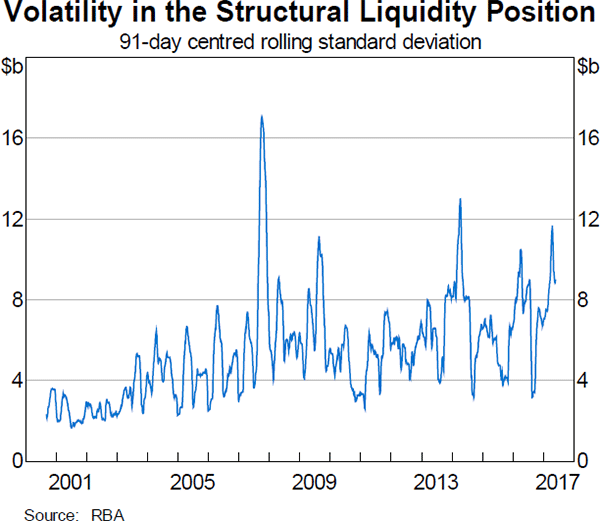
Summary
Domestic market operations seek to ensure that there is an appropriate amount of liquidity in the financial system. Since July 2000, the Australian financial system has operated with a structural liquidity deficit. This has reflected the structure of the Reserve Bank's balance sheet, which is determined by exogenous transactions. As a result, this has meant that domestic market operations have, in net terms, been required to inject liquidity into the system.
Over time, the size of the structural liquidity deficit (and therefore domestic market operations) has varied depending on demand for Reserve Bank liabilities. It has also been affected by reserves replenishment activities in the early 2000s. Notably, the steady growth in the demand for banknotes consistently added to the deficit. At the same time, changes in government deposit balances have helped to drive changes in the structural liquidity position. In accommodating the liquidity needs of the financial system, the Reserve Bank has supplied liquidity through reverse repos, foreign exchange swaps and the outright purchase of securities.
Appendix A: The Impact of Transactions on Liquidity and the Balance Sheet
A stylised central bank balance sheet is constructed to analyse the effects of different types of transactions on the structural liquidity position. By appropriately classifying the stocks on the balance sheet into two categories, reflecting whether they arise from the Reserve Bank's domestic market operations or as a result of exogenous transactions, it is possible to examine how exogenous transactions have influenced the domestic market operations conducted by the Reserve Bank.
The purchase of banknotes by a commercial bank, such as to restock its ATMs, is an example of an exogenous transaction that withdraws liquidity from the system. This is because purchases of banknotes from the Reserve Bank must be paid for using ES balances. The effect of this is to transform ES balances into another form of liability (banknotes on issue) on the balance sheet (Table A1). For example, a $2 billion purchase of banknotes increases the stock of banknotes on issue by $2 billion while simultaneously reducing system liquidity (the availability of ES balances) by the same amount.
In order to ensure that total system liquidity remains consistent with demand, the Reserve Bank conducts domestic liquidity management operations to offset (sterilise) this withdrawal of liquidity. The Reserve Bank could re-inject the $2 billion of liquidity by contracting a reverse repo transaction with a financial institution. Such a transaction would restore the availability of ES balances to be in line with demand again, at $25 billion. However, it also leads to a $2 billion increase in the balance sheet as the stock of reverse repos (an asset) and ES balances (a liability) both increase by $2 billion. Regardless of the mechanism used to inject liquidity, there is a net increase in the supply of liquidity provided through the Reserve Bank's domestic market operations.
| Assets | Initial | Transaction | Sterilisation | Final |
|---|---|---|---|---|
| Domestic market operations | 85 | – | +2 | 87 |
| Reverse repos | 55 | +2 | 57 | |
| Outrights | 10 | 10 | ||
| Foreign exchange swaps | 20 | 20 | ||
| Exogenous items | 85 | – | 85 | |
| Gold and foreign exchange | 60 | 60 | ||
| Open repo | 25 | 25 | ||
| Other assets | – | – | ||
| Total assets | 170 | – | +2 | 172 |
| Liabilities | Initial | Transaction | Sterilisation | Final |
| Domestic market operations | – | – | ||
| Repos | – | – | ||
| Term deposits | – | – | ||
| Exogenous items | 170 | – | +2 | 172 |
| Deposits | 45 | 45 | ||
| Banknotes on issue | 75 | +2 | 77 | |
| ES balances | 25 | −2 | +2 | 25 |
| Capital | 15 | 15 | ||
| Other liabilities | 10 | 10 | ||
| Total assets | 170 | – | +2 | 172 |
|
Source: RBA |
||||
Exogenous transactions initiated by parties other than the Reserve Bank that result in the withdrawal of liquidity from the system are associated with an increase in demand for other central bank liabilities on the balance sheet. Such transactions include purchases of banknotes or the deposit of funds into client accounts. The Reserve Bank may also carry out transactions on its own behalf that act to reduce system liquidity. These transactions act on the asset side of the balance sheet, such as the sale of gold and/or foreign exchange reserves. Conversely, exogenous transactions that result in the creation of additional liquidity are either initiated by third parties and reflect a reduction in demand for central bank liabilities or are initiated by the Reserve Bank to purchase additional assets.
In both cases, domestic market operations seek to realign the availability of liquidity within the system to be in line with demand and will, therefore, only be conducted in response to exogenous transactions that impact upon the availability of liquidity.[18]
Deriving the Structural Liquidity Position
As exogenous transactions have an impact on the availability of liquidity, the net sum of these exogenous transactions on the central bank's balance sheet provides an indicator as to the structural liquidity position of the system. When the sum of these exogenous items is a net liability, the system would operate with a shortage of liquidity in the absence of domestic market operations. In the stylised balance sheet, the central bank has a structural liquidity deficit of $85 billion (Table A2). Over time, there will be fluctuations in the structural liquidity position as the composition of the balance sheet is influenced by exogenous transactions.
| Balance sheet | Structural liquidity position | |
|---|---|---|
| Assets | 170 | 85 |
| Reverse repos | 55 | |
| Outrights | 10 | |
| Foreign exchange swaps | 20 | |
| Gold and foreign exchange | 60 | 60 |
| Open repo | 25 | 25 |
| Liabilities | 170 | 170 |
| Repos | – | |
| Term deposits | – | |
| Deposits | 45 | 45 |
| Bankotes on issue | 75 | 75 |
| ES balances | 25 | 25 |
| Capital | 15 | 15 |
| Other liabilities | 10 | 10 |
| Structural liquidity position | −85 | |
|
Source: RBA |
||
Footnotes
The author is from Domestic Markets. [*]
For an introduction to the structure of central bank balance sheets, see Rule (2015). [1]
For further information on domestic market operations, see <https://www.rba.gov.au/mkt-operations/dom-mkt-oper.html>. [2]
Excess liquidity refers to the amount of liquidity available in the system above and beyond the level of demand for ES balances by financial institutions that is consistent with the monetary policy objective. This accounts for circumstances where the central bank supplies liquidity in excess of the demand by market participants, such as through unsterilised monetary purchases or providing monetary financing of government budget deficits. In such cases, the excess supply of liquidity on the central bank's balance sheet would need to be subtracted from the balance sheet calculation. However, this is not the case for the Reserve Bank. Similar definitions of structural liquidity can be found in Aamodt and Tafjord (2013) and Nessén, Sellin and Åsberg Sommar (2011). [3]
Further information on the long-run demand for banknotes can be found in Cusbert and Rohling (2013). [4]
For further details, see Vallence (2012). [5]
For further details, refer to the Reserve Bank's annual reports over this period. In particular, RBA (2006) provides a summary of reserves replenishment operations. [6]
If the Reserve Bank supplies ES balances in excess of market demand, then the excess supply of balances should make institutions more eager to lend funds, and therefore places downward pressure on the cash rate. Conversely, if the Reserve Bank were to supply too few balances, then the cash rate would come under upward pressure as institutions compete for the available balances. For further details, see RBA (2003) and Debelle (2008a). [7]
The introduction of same-day settlement of DE is described in more detail in RBA (2014) and Fraser and Gatty (2014). [8]
Further information on the demand for ES balances arising from the LCR can be found in RBA (2015). [9]
For further details on liquidity forecasting, see Baker and Jacobs (2010). [10]
For information on domestic market operations and the instruments used, see <https://www.rba.gov.au/mkt-operations/dom-mkt-oper.html>. [11]
On occasion, the Reserve Bank has withdrawn liquidity from the system using repos, foreign exchange swaps, term deposits and sales of outright securities. Such transactions have been conducted relatively infrequently, typically on days where there has been a significant increase in structural liquidity or to fine-tune system liquidity. [12]
In 2001, it was estimated that, if the structural liquidity deficit was offset using only reverse repos, then the Reserve Bank would hold about 40 per cent of all securities issued by the Australian and state governments (RBA 2001). By comparison, if the current structural liquidity deficit was sterilised entirely through reverse repos secured by Australian and state government securities, the Reserve Bank would hold around 10 per cent of the combined total of securities. [13]
The decision to widen access to domestic securities rather than rely even more on foreign exchange swaps also reflected a desire on the part of the Reserve Bank to maintain flexibility in managing the composition of the assets on its balance sheet. For further details, see RBA (2003) and RBA (2004). For a summary of the timeline of the expansion of eligible collateral, see Debelle (2008b). [14]
Further details on the role of foreign exchange swaps during this period can be found in RBA (2008a). [15]
The domestic liquidity management implications of these structural liquidity events, typically public sector pay days and transfers of GST receipts to the states, are described in RBA (2003). [16]
For further details, see RBA (2008b). [17]
Changes in the demand for liquidity by participants translate into a change in the demand for ES balances. While there is no explicit exogenous transaction directly affecting the central bank balance sheet in this case, domestic liquidity management operations must nevertheless accommodate the exogenous change in demand for this liability. [18]
References
Aamodt K and E Tafjord (2013), ‘Structural Liquidity’, Norges Bank Economic Commentaries 9/2013.
Baker A and D Jacobs (2010), ‘Domestic Market Operations and Liquidity Forecasting’, RBA Bulletin, December, pp 37–43 .
Cusbert T and T Rohling (2013), ‘Currency Demand during the Global Financial Crisis: Evidence from Australia’, RBA Research Discussion Paper No 2013-01.
Debelle G (2008a), ‘Open Market Operations’, Australian Debt Markets Conference 2008, Sydney, 27 June.
Debelle G (2008b), ‘Market Operations in the Past Year’, 2008 FTA Congress, Melbourne, 31 October.
Fraser S and A Gatty (2014), ‘The Introduction of Same-day Settlement of Direct Entry Obligations in Australia’, RBA Bulletin, June, pp 55–64.
Nessén M, P Sellin and P Åsberg Sommar (2011), ‘The Framework for the Implementation of Monetary Policy, the Riksbank's Balance Sheet and the Financial Crisis’, Sveriges Riksbank Economic Commentaries No 1.
RBA (Reserve Bank of Australia) (2001), ‘Operations in Financial Markets’, Reserve Bank of Australia Annual Report 2001, pp 5–20.
RBA (2003), ‘The Reserve Bank's Open Market Operations’, RBA Bulletin, June, pp 1–7.
RBA (2004), ‘Operations in Financial Markets’, Reserve Bank of Australia Annual Report 2004, pp 5–15.
RBA (2006), ‘Operations in Financial Markets’, Reserve Bank of Australia Annual Report 2006, pp 5–12.
RBA (2008a), ‘Box A: The RBA's Foreign Exchange Swaps’, Statement on Monetary Policy, February, pp 23–24.
RBA (2008b), ‘The Balance Sheet and Operations in Financial Markets’, Reserve Bank of Australia Annual Report 2008, pp 14–24.
RBA (2014), ‘Operations in Financial Markets’, Reserve Bank of Australia Annual Report 2014, pp 23–33.
RBA (2015), ‘Operations in Financial Markets’, Reserve Bank of Australia Annual Report 2015, pp 37–46.
Rule G (2015), ‘Understanding the Central Bank Balance Sheet’, Centre for Central Banking Studies Handbook No. 32, Bank of England.
Vallence C (2012), ‘Foreign Exchange Reserves and the Reserve Bank's Balance Sheet’, RBA Bulletin, December, pp 57–63.